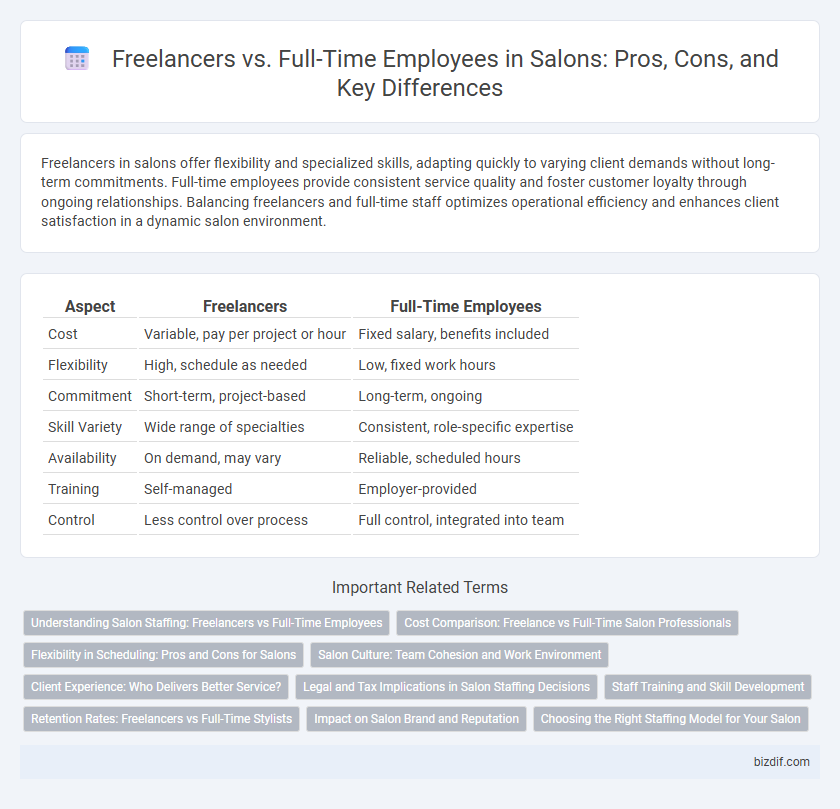Freelancers in salons offer flexibility and specialized skills, adapting quickly to varying client demands without long-term commitments. Full-time employees provide consistent service quality and foster customer loyalty through ongoing relationships. Balancing freelancers and full-time staff optimizes operational efficiency and enhances client satisfaction in a dynamic salon environment.
Table of Comparison
| Aspect | Freelancers | Full-Time Employees |
|---|---|---|
| Cost | Variable, pay per project or hour | Fixed salary, benefits included |
| Flexibility | High, schedule as needed | Low, fixed work hours |
| Commitment | Short-term, project-based | Long-term, ongoing |
| Skill Variety | Wide range of specialties | Consistent, role-specific expertise |
| Availability | On demand, may vary | Reliable, scheduled hours |
| Training | Self-managed | Employer-provided |
| Control | Less control over process | Full control, integrated into team |
Understanding Salon Staffing: Freelancers vs Full-Time Employees
Salon staffing involves a strategic choice between freelancers and full-time employees, each offering unique benefits. Freelancers provide flexibility and specialized skills for peak periods or specific services, while full-time employees ensure consistent quality, brand loyalty, and team cohesion. Understanding the balance between these staffing models helps salons optimize operational efficiency and enhance client satisfaction.
Cost Comparison: Freelance vs Full-Time Salon Professionals
Freelance salon professionals typically incur lower fixed costs since they manage their own supplies, taxes, and insurance, reducing overhead expenses for salon owners. Full-time employees demand consistent salaries, benefits, and paid time off, contributing to higher operational costs but offering stability and loyalty. Choosing freelancers can enhance budget flexibility, while full-time staff provide consistent service quality, affecting the salon's overall financial strategy.
Flexibility in Scheduling: Pros and Cons for Salons
Freelancers in salons offer unmatched flexibility in scheduling, allowing businesses to adjust workforce availability during peak hours or special events without long-term commitment. Full-time employees provide consistent availability and reliability, which supports steady client appointments and operational stability but may limit the salon's ability to adapt quickly to fluctuating demand. Balancing freelancers and full-time staff can optimize scheduling efficiency while addressing both flexibility and continuity in salon services.
Salon Culture: Team Cohesion and Work Environment
Freelancers in salons offer flexibility but may face challenges integrating fully into the salon culture, potentially impacting team cohesion and the overall work environment. Full-time employees contribute to a consistent, collaborative atmosphere that fosters strong relationships, essential for maintaining a positive client experience and efficient salon operations. Prioritizing team-building activities and open communication helps salons balance the benefits of both staffing models while preserving a unified workplace culture.
Client Experience: Who Delivers Better Service?
Freelancers in salons often provide highly personalized client experiences due to flexible scheduling and specialized skills tailored to individual needs. Full-time employees contribute consistent service quality and deeper familiarity with salon standards and repeat clients, fostering trust and loyalty. Client satisfaction ultimately hinges on the balance between personalized attention from freelancers and the reliable, cohesive service offered by full-time staff.
Legal and Tax Implications in Salon Staffing Decisions
Salon staffing decisions involving freelancers versus full-time employees significantly impact legal and tax liabilities. Freelancers in salons typically manage their own taxes and benefits, reducing employer obligations but requiring strict contract clarity to avoid misclassification risks under labor laws. Full-time employees necessitate comprehensive payroll handling, including tax withholdings, workers' compensation, and adherence to employment regulations, increasing the salon's administrative responsibilities and potential legal exposure.
Staff Training and Skill Development
Freelancers in salons often bring specialized skills and require less initial training, allowing for flexible scheduling but may have limited access to ongoing professional development programs. Full-time employees benefit from structured staff training initiatives, continuous skill development, and consistent mentorship, fostering loyalty and higher service quality. Investing in comprehensive training for full-time staff enhances client satisfaction and business reputation, while freelancers support adaptability and niche expertise.
Retention Rates: Freelancers vs Full-Time Stylists
Retention rates for full-time stylists in salons are typically higher than those for freelancers due to consistent scheduling, benefits, and a stronger sense of workplace loyalty. Freelancers often face fluctuating client demand and lack employer-provided incentives, contributing to increased turnover and lower retention. Salons aiming to improve stylist retention should consider offering competitive benefits and professional development opportunities to full-time staff while addressing freelancers' need for flexible yet stable work arrangements.
Impact on Salon Brand and Reputation
Freelancers bring diverse skills and fresh perspectives that can enhance a salon's brand by appealing to a broader clientele and showcasing innovative trends. Full-time employees contribute to consistent service quality and stronger client relationships, reinforcing the salon's reputation for reliability and trust. Balancing both types of workers allows salons to maintain a dynamic, reputable brand while ensuring dependable customer experiences.
Choosing the Right Staffing Model for Your Salon
Selecting the ideal staffing model for your salon hinges on your business size, budget, and service demand patterns. Freelancers offer flexibility and specialized skills, reducing long-term costs, while full-time employees provide consistent client relationships and stable team dynamics. Analyzing peak hours, client loyalty, and operational control needs ensures optimal balance between freelance agility and full-time reliability.
Freelancers vs Full-Time Employees Infographic

 bizdif.com
bizdif.com